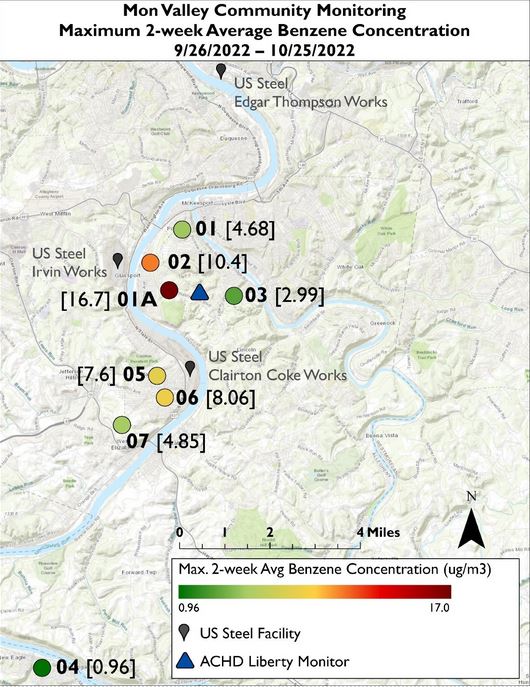
Monitoring at Residential Properties Downwind from US Steel Plants Reveals Benzene Levels that Pose Health Risks.
Pittsburgh – In a letter to EPA today, EIP urged EPA to order US Steel to monitor benzene concentrations at the perimeter of each of its three Monongahela Valley Plants, and to take corrective action whenever their fenceline benzene levels exceed certain thresholds already in place for refineries and some petrochemical plants. The groups found unhealthy levels of benzene, a hazardous air pollutant that can irritate the skin, eyes, and throat, and lead to additional health problems, at two homes near the plants.
The letter also urges EPA to address unhealthy levels of fine particulate matter (PM2.5) and hydrogen sulfide in the same communities. PM2.5 exceeded federal air quality standards for six days in October and November, while hydrogen sulfide levels were above state air quality standards more than twenty days. Eight local groups and a handful of community members have signed onto the letter.
In October, EIP found that two-week average concentrations of benzene at two residences near the US Steel Clairton and Irvin Works plants exceeded 10 and 16 µg/m3 (micrograms per cubic meter of air). Given that benzene concentrations can vary widely over short periods of time, 24-hour concentrations may have exceeded 29 µg/m3 for at least one or two days during that two-week period in these communities. The U.S. Agency for Toxic Substances Disease Registry (ATSDR) estimates that exposure to benzene concentrations above 29 µg/m3 for as little as 24 hours can increase the risk of noncancerous health effects like a weakened immune system.
“Benzene concentrations this high are just not acceptable,” said EIP Deputy Director Jen Duggan. “Local authorities have repeatedly failed to seriously address toxic pollution from the U.S. Steel plants, and we are asking EPA to step in and provide the necessary relief for these communities and workers at the plant.”
Cindy and Dave Meckel, Glassport residents, say that pollution affects their quality of life. “We cannot work in our yard or enjoy being outside. We fear pollution is having serious impacts on our health.”
Another Glassport resident hosting one of the community monitors is concerned for their family’s health. “The smell we wake up to is not only on the outside, but also the inside, of our homes. Some days we can taste the pollution in our mouths.”
Germaine Gooden-Patterson, long-time resident of Clairton and steering committee member of Valley Clean Air Now (VCAN) continues to look for much needed accountability from these plants: “The most important ask and the bottom line is the protection of public health. Residents, specifically in the Mon Valley (Clairton) should not have to suffer at the cost of industry financial gains. My health is at risk, my children’s health is at risk and my neighbor’s health is at risk.”
Since monitoring began in December of 2021, the average benzene concentrations through November 22 at the two homes are above 3 µg/m3, the level that California has determined may undermine immune systems and increase vulnerability to disease if exposed for several years. A third community monitor near US Steel Clairton is approaching this long-term threshold at 2.93 µg/m3. Benzene levels at these residences are comparable to those found in neighborhoods surrounded by chemical plants and refineries in Texas. For example, benzene concentrations at the Galena Park monitor in the Houston Ship Channel, which is located downwind from several refineries, averaged 3.16 µg/m3 in 2021.
EPA regulations require refineries to identify and cleanup their emission sources whenever the annual concentration of benzene (excluding background) exceeds 9 micrograms. This threshold is meant to avoid the kind of offsite, residential exposures that EIP found in Monongahela Valley communities.

The Allegheny County Health Department’s (ACHD) air quality monitor in Liberty Borough, which monitors emissions from U.S. Steel operations, recorded numerous days of federal and state air quality standard exceedances of PM2.5 (6 days) and hydrogen sulfide (23 days) in October and November alone. Exposure to particulate matter can irritate the eyes, nose, and throat, and over the long term can cause reduced lung function. Short-term exposure to hydrogen sulfide can lead to headaches, nausea, tremors, and skin and eye irritation. Long-term exposure to hydrogen sulfide can lead to more severe health impacts.
EIP is urging EPA to use the full extent of its authority under the Clean Air Act to reduce benzene and other toxic emissions in Mon Valley communities near U.S. Steel plants. Including, at a minimum, immediately inspecting, investigating, and enforcing all necessary relief to end potential violations from sources emitting benzene and other toxic emissions; requiring U.S. Steel to install and operate a fenceline monitoring system for benzene and other toxic air emissions; and exercising permitting oversight and authority over U.S. Steel Clean Air Act permits.
EIP, in partnership with the Breathe Project and the Carnegie Mellon University (CMU) Create Lab, installed the eight passive benzene monitoring stations in Mon Valley communities in December of 2021. Six out of the eight monitors are located within two miles of the U.S. Steel Clairton and Irvin Works plants. The passive benzene monitoring tubes are provided and analyzed by Enthalpy Analytical using EPA Method 325A/B, which is the same method used by refineries to monitor benzene concentrations at fencelines in accordance with federal rules.
Signers to the letter include Breathe Project, Carnegie Mellon University CREATE Lab, Valley Clean Air Now, Clean Air Council, Clean Water Action, Penn Future, PennEnvironment Research & Policy Center, Protect Elizabeth Township, and several community members.
For a copy of the letter, click here.
The Environmental Integrity Project is a nonprofit organization dedicated to enforcing environmental laws and strengthening policy to protect communities and the environment from industrial pollution.
Media Contacts:
Ari Phillips, aphillips@environmentalintegrity.org
Lisa Graves Marcucci, (412) 897-0569 or lgmarcucci@environmentalintegrity.org


